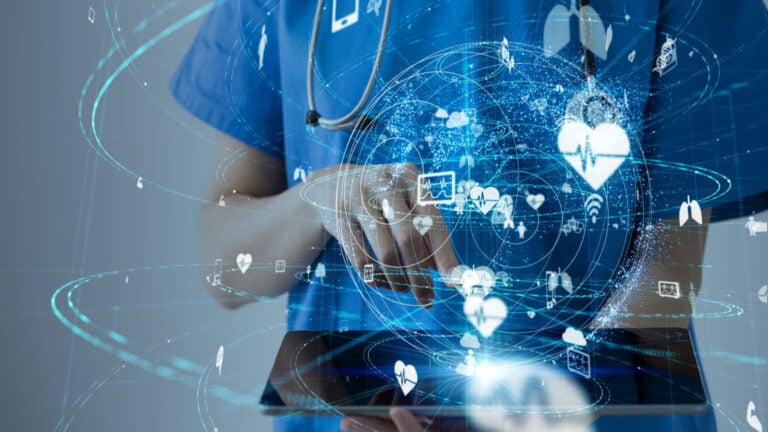When Thomas Edison switched on his famous light bulb in 1879, his audience probably never imagined that someone would also harness electricity to power mundane household items like a toothbrush or a razor. Nor could any of them have known that electricity would power future inventions like microwave ovens, video cameras… or mobile phones.
Similarly, we today cannot possibly imagine all the ways future generations might harness and utilize our new power: artificial intelligence.
Luckily, we don’t have to imagine the revolutionary changes AI will bring.
They’re already in motion – particularly in the healthcare industry.
A Failsafe System
AI technology is stretching its tentacles into nearly every corner of medical diagnosis, treatment, and patient care. As a recent bulletin from the U.S. Food and Drug Administration remarked…
As technology continues to advance every aspect of health care… the subset of AI known as machine learning (ML), has become an important part of an increasing number of medical devices. One of the greatest potential benefits of AI/ML resides in its ability to create new and important insights from the vast amount of data generated during the delivery of health care every day.
So far, AI has made the biggest splash in diagnostic specialties like radiology, pathology, and dermatology. Nearly 80% of the 692 AI-enabled medical devices approved by the U.S. Food and Drug Administration perform some sort of imaging function.
The algorithm and the radiologists independently examined the identical 100-plus stack of chest X-rays. On average, each of the radiologists needed about four hours to examine all the X-rays. But the algorithm completed the same analysis in 90 seconds and did so with similar diagnostic accuracy.
Another study showed that by using AI, pathologists decreased their error rate in recognizing cancer-positive lymph nodes from 3.4% to 0.5%. In other words, AI slashed the diagnostic error rate by a stunning 85%!
Despite that analytical prowess, AI does not yet replace radiologists; it assists them by finding the occasional cancerous needle in a haystack. AI sometimes picks up small, rare spots that escape detection from radiologists. As one physician remarked, “It’s almost like a backup or a failsafe system that can run in the background to look at the scan and see if we missed anything.”
But radiology is only one of the medical fields that is starting to apply AI technologies at scale…
Friendly Robots
AI is also “scrubbing up” and entering the operating room to assist surgeons.
Already, AI-powered robots are enhancing surgical precision throughout certain operations. Jason Davis, M.D., an esteemed joint replacement surgeon at Henry Ford Health, likens robotic-assisted surgeries to the rearview cameras and sensors on cars that making parking easier.
One of my recent recommendations in my Fry’s Investment Report trading research service has already developed a line of surgical robot systems to guide orthopedists through operations on most major joints of the human body.
The company’s proprietary tool provides physical guidance and data-driven insights to help surgeons complete direct anterior hip replacements, a minimally invasive approach to total replacement procedures.
During the operation, the system displays real-time fluoroscopy images and automatically calculates leg length, orientation, and joint offsets to help ensure the proper placement of hip implants.
You can learn more about this company – and others like it in the healthcare space – by clicking here.
Opportunity Abounds
The healthcare AI story is not only about surgical robots and the gee-whiz products of the future; it is also a story about enormous economic activity. The global healthcare market is already a $12 trillion behemoth.
Here in the U.S., it accounts for nearly one-fifth of our entire GDP… and rising. The upward trend is unmistakable.
Clearly, opportunity abounds in the healthcare AI field. And this opportunity walks hand-in-hand with massive societal benefits. In other words, investing in healthcare AI is a classic example of doing well by doing good.
Unlike many other facets of the AI-enabled future we might imagine, no dystopian dark cloud hangs over the future healthcare industry.
As Dr. Jennifer Eckhoff, AI and Innovation Fellow at the Surgical Artificial Intelligence and Innovation Laboratory at Massachusetts General Hospital, remarked…
I’m genuinely concerned about the rapid adaption of AI into our daily lives. But with respect to application of AI to medicine and surgery, we’re not moving fast enough.
When it comes to artificial intelligence in healthcare, the future is here. And what comes next could be transformative.
In fact, it seems that every field or corner AI expands to is getting ready to transform.
We’re reaching a technological tipping point… one that calls for an AI Code Red.
So, I created a short presentation to help you prepare for what’s coming.
I’ll also show you where to uncover the biggest potential profits from the $15.7 trillion A.I. Revolution… by focusing on a virtually ignored sector that’s set to explode in the days and months ahead.
The sector I’ve identified offers a shot at the kind of explosive gains early investors captured at the beginning of the internet era.
And you can access this urgent presentation for free… for a limited time.
Click here for all the details.
Regards,
Eric


